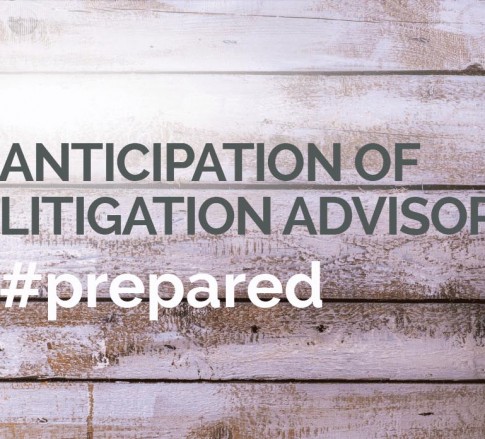"I'm Only Human"
June 26, 2019
By: Jessica L. Robey
Attorneys are limited in the number of documents they can review and identify per day in a large discovery production. Luckily, technology-assisted review (“TAR”) is a useful tool to expedite review time when humans cannot handle it all. When set up correctly, TAR can return more accurate and complete results than any human review team, and can do it much faster. This is good news because we’re only human, after all.
What is TAR? TAR is a concept-based method of document coding that leverages machine-learning techniques with the input of human reviewers to automate the review process.[1] TAR creates algorithms to identify and tag potentially responsive documents based on keywords and other metadata.[2] The documents identified as responsive are produced in discovery after they are further reviewed by humans for privilege, confidential content, and responsiveness.
How does TAR typically work? Attorneys initially review and code a subset of data from the overall collection, referred to as the “seed set”. The TAR software then compares the human coding against each document’s content, determining what makes a document more likely to be relevant for purposes of production. An algorithm built into the technology then applies the reviewer’s logic to classify documents across the data collection as responsive or unresponsive. As reviewers continue to feed additional coded documents into the system to “train” the computer, the technology refines its decision-making ability by “learning” what is relevant. The accuracy of the process increases as TAR becomes more informed.[3] Once the computer has “learned” what documents are relevant to the case, it comes up with a production set that can be produced in discovery once the set is further reviewed by humans for privilege, confidential content, and responsiveness.
Does TAR Meet the Requirements of Federal Rule 26(g)? Under Federal Rule of Civil Procedure 26(b)(1), a party may obtain documents “relevant to [his or her] claim or defense” by propounding document requests. Federal Rule of Civil Procedure 26(g) also requires an attorney to certify that a discovery response is made “to the best of …knowledge, information and belief formed after a reasonable inquiry.” (emphasis added). The Committee Notes to Rule 26 state that “[t]he duty to make a ‘reasonable inquiry’ is satisfied if the investigation under-taken by the attorney and the conclusions drawn therefrom are reasonable under the circumstances.”
While TAR is not a perfect method of identifying relevant documents, the rules do not require perfection.[4] The fact that TAR will never yield perfect results does not mean that the use of a TAR system cannot be considered a “reasonable inquiry.” [5] Research suggests the traditional methods of manual document review and use of search terms to identify responsive documents also result in many missed documents due to error in human judgment or improper search terms.[6]
What do Courts Think About TAR? In Da Silva Moore v. Publicis Groupe, a Southern District of New York opinion, the Court discussed the use of TAR in discovery:
This Opinion appears to be the first in which a Court has approved of the use of computer-assisted review. That does not mean computer-assisted review must be used in all cases, or that the exact ESI protocol approved here will be appropriate in all future cases that utilize computer-assisted review… What the bar should take away from this opinion is that… computer-assisted review is an available tool and should be seriously considered for use in large-data-volume cases where it may save the producing party (or both parties) significant amounts of legal fees in document review. Counsel no longer have to worry about being the “first” or “guinea pig” for judicial acceptance of computer-assisted review…” [7]
Since Da Silva Moore, courts have consistently held a party may rely on TAR. [8]
As electronic information is stored more inexpensively and at higher volumes and discovery becomes more and more overwhelming, TAR programs are here to help and, according to many courts, are here to stay. Thanks to TAR software, we don’t have to do it all by ourselves—and thank goodness, because we’re only human, after all.
Author: Jessica Robey, Attorney, General Litigation Practice Group
© June 2019 Jackson Kelly, PLLC
[1] https://www.ktlitsmart.com/blog/technology-assisted-review-or-how-i-stopped-worrying-and-learned-love-computer-program-part-one.
[2] https://www.zapproved.com/blog/what-is-technology-assisted-review-tar/
[3] https://www.ktlitsmart.com/blog/technology-assisted-review-or-how-i-stopped-worrying-and-learned-love-computer-program-part-one.
[4] See Da Silva Moore, 287 F.R.D. at 182, 193.
[5] Technology-Assisted Review for Discovery Requests, a Pocket Guide for Judges, written by Timothy T. Lau, and Emery G. Lee, III, 2017.
[6] See generally Maura G. Grossman & Gordon V. Cormack, Technology-Assisted Review in E-Discovery Can be More Effective and Efficient Than Exhaustive and Manual Review, 17 Richmond J.L. & Tech. 11 (2017).
[7] Da Silva Moore v. Publicis Groupe, 287 F.R.D. 182, 193 (S.D.N.Y. 2012).
[8] See, e.g., Davine v. The Golub Corp., 2017 U.S. Dist. LEXIS 18109, at *3 (D. Mass Feb. 8, 2017); Rio Tinto PLC v. Vale S.A., 306 F.R.D. 125, 127 (S.D.N.Y. 2015)(“In the three years sine Da Silva Moore, the case law has developed to the point that it is now black letter law that where the producing party wants to utilize TAR for document review, courts will permit.”).



